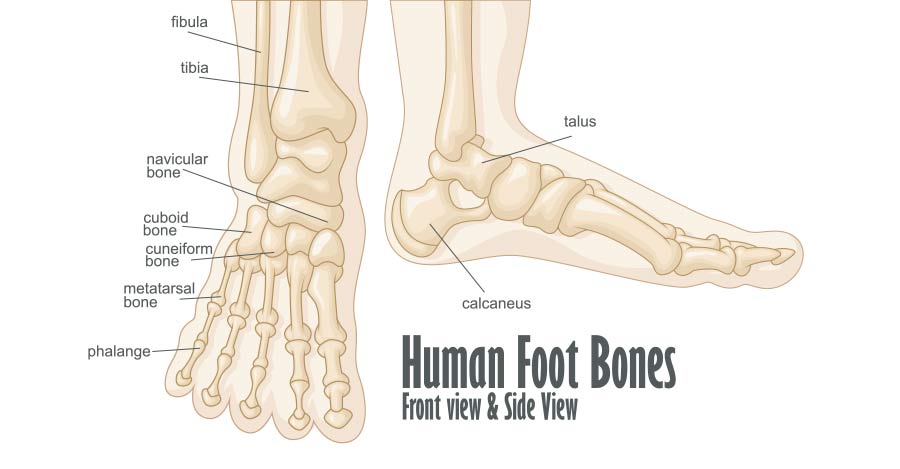Broken Foot & Foot Fracture: Causes, Symptoms, Treatments & Recovery
Interestingly, according to American clinical statistics, millions of people suffer from broken bones, commonly referred to as foot fractures, each year. Are you suffering from a foot injury? If so, you could likely be one of the many people to have a fracture or break in your foot.
The easiest way to determine if you indeed have a fracture or break is to evaluate your injury. In this article, we will evaluate the causes and symptoms of a broken foot and foot fracture. We will also look into the treatment option available and the recovery time.
How Many Bones Are in A Person’s Foot?

Do you know that close to one-fourth of all the bones in your body are in your feet? In your foot there are over 100 muscles, 30 joints, and 26 bones. All these components work together to provide support for your body’s weight. Your feet play a huge role in permitting you to complete daily tasks and activities.
The main bones in your foot are the calcaneus, the biggest foot bone, and the talus, a bone on top of your foot. There are the tarsals which are five oddly shaped bones in your midfoot. There are metatarsals which are five bones that make up your forefoot. Additionally, you also have phalanges which are 14 bones in your toes, and sesamoids, two small bones in the ball of your foot.
What Are The Symptoms Associated With A Broken Foot Or Foot Fracture?
Few people know that any fracture correlates with a broken foot. That means that a break can be anything from a small crack to an open fracture and a complete break. If the bone has not broken the skin of your foot when it breaks, it is hard to determine that you have broken it.
Small breaks or cracks in your bone can also be hard to identify. This is because they often don’t hurt as much as a complete break. Yet, a few standard broken foot and foot fracture symptoms can help you identify if you have a break.
- A toe of foot deformity.
- Breaking or grinding sound in the foot region.
- Painful foot movements.
- Puncture marks or the appearance of bone shards through the skin.
- Trouble walking, running, or placing weight on your foot due to pain.
- Swelling, bruising, and discoloration.
- A feeling of faintness, nausea, or dizziness at the time of hurting your foot.
- A foot that is tender to the touch.
Causes Associated With A Broken Foot Or Foot Fracture

Broken bones or foot fractures are seen more in children than in adults. Broken bones or foot fractures attribute to approximately 10 percent of broken bones.
They are more common amongst dancers, soldiers, and professional or amateur athletes. For example, stress fractures are a specific subclass of breaks that many athletes such as basketball players, football players, and runners suffer. This is because of the high impact nature of these activities.
Usually, a broken foot occurs when a person trips, kicks something, stumbles, falls, or jumps. A break can also happen when a heavy object hits a person’s foot. Breaks can also occur over time. A break can develop as a small microscopic crack. This crack will continue to worsen with repetitive motions. After a time, it will become a complete break.
- Foot fractures to the calcaneus bone often occur when you fall or jump from a height and land on your feet.
- Foot fractures to the metatarsals and phalanges usually occur when you take a direct blow to your foot. For example, blows could happen when you suffer a crush injury, kick something wrong, or have an object fall on your foot.
- Foot fractures can result from twisting motions. Often rolling your ankle inward can result in a fifth metatarsal fracture.
The Treatments Available For A Broken Foot or Foot Fracture
If you have a broken foot or foot fracture, there are several treatment options available. Often a bone break can heal without surgery if it is minor. Yet, sometimes it is necessary to undergo surgery if you have a significant break. Below are a few of the treatment options you should consider.
Rice Method
The rice method is a frequently used treatment for those with foot fractures. You will need to rest and stay off your foot or make sure to limit the amount of pressure you place on it while it heals. If you walk unnecessarily on the hurt foot, you could make the break worse or prevent it from healing.
Next, you will need to ice your foot either with an ice pack or a back of freezer vegetables. Applying ice will reduce the swelling of your foot and help ease the pain. You should ice your foot for twenty-minute intervals a few times a day without overdoing it. Don’t apply the ice to your exposed skin, as this will cause more harm.
Another integral aspect of the rice method is compression. To reduce swelling and promote healing, you need to compress the injury in your foot by using a soft bandage. Yet, you don’t want to make it too tight, especially if you suspect a break. Lastly, you will have to elevate your hurt foot. To do this place pillows underneath your foot and raise it above the level of your heart. Doing this will also reduce pain and swelling.
Medication
Before seeing a doctor, it might be best to take over-the-counter anti-inflammatory medication. Medicines such as Ibuprofen will help reduce the swelling. Thus allowing you to determine if your foot does have a fracture or break.
Surgery
Surgery is often not needed for most people who have a broken bone, but it’s sometimes necessary for other people. A doctor will usually need to examine your foot in a physical exam and through imaging methods like an X-ray.
If they determine your injury is severe enough to do a surgery, you will need medical equipment to put into your foot. For example, an orthopedic surgeon could place metal screws, pins, or metal plates to fix the break. These medical devices will promote healing. They make sure your bones are in the correct alignment.
Cast Boots
A prevalent treatment option is placing your foot into a cast while the break heals. Sometimes this will involve a plaster cast, but other times a doctor will prescribe a cast boot. The cast will immobilize your foot for between six to twelve weeks. Thus, helping the fracture heal properly.
Recovery And Rehabilitation For Foot Fractures
The recovery time for a broken foot or foot fracture is generally between six to twelve weeks. Yet, this will depend on the severity of your injury. Yet, if you have to have surgery, the recovery time is between three to four months.
Commonly rehabilitative measures involve you using a mobility aid. With a mobility aid, you can do your daily activities without re-injuring your foot. Additionally, mobility aids also help in a faster recovery.
It’s better to use a mobility device. Placing even slight pressure on your broken foot could disrupt the healing process.
Do You Need Crutches For A Broken Foot And Foot Fracture?
Two to Four times a day; you need to do toe stretches. These stretches are done by pulling your big toe towards your ankle. Once you do this, you need to keep your big toe in this position for 30 to 45 seconds at a time.
Final Words
Having a foot injury can be challenging, especially if you don’t know what could be wrong. After reading this foot fracture article, you should understand how to identify a broken bone.
As long as you know the symptoms and causes, you will be able to identify the nature of your foot injury. If you think that you have this type of injury, you now know the available treatment options. You also now know that you should use a mobility aid like crutches to hasten your recovery.


